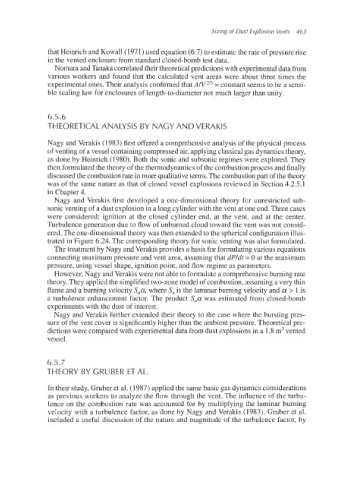Page 496 - Dust Explosions in the Process Industries
P. 496
Sizing of Dust Explosion Vents 463
that Heinrich and Kowall(1971) used equation (6.7) to estimate the rate of pressure rise
in the vented enclosure from standard closed-bomb test data.
Nomura and Tmaka correlated their theoretical predictions with experimental data from
various workers and found that the calculated vent areas were about three times the
experimental ones. Their analysis confirmed that AIV2’3= constant seems to be a sensi-
ble scaling law for enclosures of length-to-diameter not much larger than unity.
6.5.6
THEORETICAL ANALYSIS BY NACY AND VERAKIS
Nagy and Verakis (1983) first offered a comprehensive analysis of the physical process
of venting of a vessel containing compressed air, applying classical gas dynamics theory,
as done by Heinrich (1980). Both the sonic and subsonic regimes were explored. They
then formulated the theory of the thermodynamics of the combustion process and finally
discussed the combustion rate in more qualitativeterms. The combustion part of the theory
was of the same nature as that of closed vessel explosions reviewed in Section 4.2.5.1
in Chapter 4.
Nagy and Verakis first developed a one-dimensional theory for unrestricted sub-
sonic venting of a dust explosion in a long cylinder with the vent at one end. Three cases
were considered[: ignition at the closed cylinder end, at the vent, and at the center.
Turbulence generation due to flow of unburned cloud toward the vent was not consid-
ered. The one-dimensional theory was then extended to the spherical configuration illus-
trated in Figure 6.24. The corresponding theory for sonic venting was also formulated.
The treatment by Nagy and Verakis provides a basis for formulating various equations
connecting maximum pressure and vent area, assuming that dPIdt = 0 at the maximum
pressure, using vessel shape, ignition point, and flow regime as parameters.
However, Nagy and Verakis were not able to formulate a comprehensive burning rate
theory. They applied the simplified two-zone model of combustion, assuming a very thin
flame and a burning velocity Sua,where S, is the laminar burning velocity and a > 1is
a turbulence enhancement factor. The product Suawas estimated from closed-bomb
experiments with the dust of interest.
Nagy and Verakis further extended their theory to the case where the bursting pres-
sure of the vent cover is significantly higher than the ambient pressure. Theoretical pre-
dictions were compared with experimental data from dust explosions in a 1.8m3vented
vessel.
6.5.7
THEORY BY GRUBER ET AL.
In their study, Gruber et al. (1987) applied the same basic gas dynamics considerations
as previous workers to analyze the flow through the vent. The influence of the turbu-
lence on the combustion rate was accounted for by multiplying the laminar burning
velocity with a turbulence factor, as done by Nagy and Verakis (1983). Gruber et al.
included a useful discussion of the nature and magnitude of the turbulence factor, by

